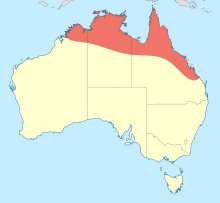Rhyothemis braganza
Rhyothemis braganza, known as the Iridescent flutterer,[3] is a species of dragonfly in the family Libellulidae.[4][5] The genus Rhyothemis extends from Africa to the western Pacific, with five species known in Australia. Rhyothemis braganza inhabits streams, rivers and riverine pools on, and adjacent to, the coast in Queensland, Northern Territory and northern Western Australia.
| Rhyothemis braganza | |
|---|---|
.jpg) | |
| Iridescent flutterer, Darwin NT | |
| Scientific classification | |
| Kingdom: | Animalia |
| Phylum: | Arthropoda |
| Class: | Insecta |
| Order: | Odonata |
| Infraorder: | Anisoptera |
| Family: | Libellulidae |
| Genus: | Rhyothemis |
| Species: | R. braganza |
| Binomial name | |
| Rhyothemis braganza | |
 | |
| Synonyms | |
|
Rhyothemis alcestic Tillyard, 1906 | |
Rhyothemis braganza is a medium-sized dragonfly with a wingspan of 60-85mm. On the adult, dark markings on the forewing and hindwing are of similar length and lack pale spots which appear on the similar species Rhyothemis resplendens.[3] The taxon has been assessed for the IUCN Red List as being of least concern.
Gallery
.jpg) Female wings
Female wings.jpg) Male wings
Male wings
gollark: collider'); DROP TABLE particles;--
gollark: The Torus of Satan
gollark: Non-Explosive Collider
gollark: It's Safe I Tell You Collider
gollark: Please Ignore Any Nearby Black Holes Collider
See also
References
| Wikimedia Commons has media related to Rhyothemis braganza. |
- Dow, R.A. (2017). "Rhyothemis braganza". IUCN Red List of Threatened Species. 2017: e.T87535206A87540039. doi:10.2305/IUCN.UK.2017-1.RLTS.T87535206A87540039.en.
- Karsch, F. (1890). "Beiträge zur Kenntniss der Arten und Gattungen der Libellulinen". Berliner Entomologische Zeitschrift (in German). 33: 347–392 [354] – via Biodiversity Heritage Library.
- Theischinger, Gunther; Hawking, John (2006). The Complete Field Guide to Dragonflies of Australia. Collingwood Vic.: CSIRO. p. 284. ISBN 0643090738.
- "Species Rhyothemis braganza Karsch, 1890". Australian Faunal Directory. Australian Biological Resources Study. 2012. Retrieved 2 March 2017.
- Schorr, Martin; Paulson, Dennis. "World Odonata List". Slater Museum of Natural History. University of Puget Sound. Retrieved 2 March 2017.
This article is issued from Wikipedia. The text is licensed under Creative Commons - Attribution - Sharealike. Additional terms may apply for the media files.
